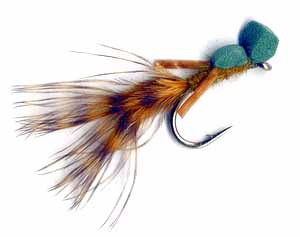 |
|
FLY-TYER'S CORNER Paul Egan |
|
Terry Barron’s Swimming Damsel Nymph
Terry Barron has been fly fishing for over 50 years. He is one of the most knowledgeable Reno-area fly-fishing guides, fly-tier and author of the book Guide to Fly Fishing Pyramid Lake. He has tied commercially for the Reno Fly Shop and helped establish the Truckee River Fly Fishers Club, which created Nevada’s first catch and release trophy section on the Truckee River. One of the patterns he created is this month’s fly pattern, the Barron’s Swimming Damsel Nymph.
Damselflies spend most of their lives in the nymph stage. When the damsels make their migrations to emerge, the process is very slow and a struggle. They are not good swimmers and move along slowly. Let me restate that point, as it is very important, when fishing damsel fly imitations, they move a few inches and then rest. Therefore, if you think you are retrieving the fly slowly, you’re going to fast. At Davis Lake, when the damselfly hatch starts, the dinner bell rings for the largest trout and they come running, ok swimming. However, when they pick up a damsel, it is at full speed. If you don’t have a loose drag and a good grip on your rod, you might have one less thing do pack up for the trip home. Either a floating or intermediate line will work when using this pattern. Good luck and I hope I don’t hear any reports of lost rods.
Materials
Tying instructions
1. Smash the barb and place in the vise, giving the entire hook shank a thin coating of Dave’s Flexament before starting to tie the thread. Lay down a solid layer of thread from the eye-of the hook to a point about a third of the way down the hook bend. 2. Select a small bunch of golden-olive dyed marabou, about ten to twelve fibers and break the tips off so that the fibers are even. Tie them in as a tail equal in length to the thread-covered part of the hook shank done in step one. Next, select about ten grizzly or mallard flank fibers dyed light olive and tie them in directly on top of the tail. They should be half the length of the marabou. 3. Form a dubbing loop. Sparsely add the Buggy Nymph Tan Damsel dubbing and create a “rope” by spinning the dubbing loop. Wind the “rope” forward to create a slender, segmented abdomen. The abdomen should take up about two-thirds of the hook shank, leaving room for the remainder of the fly. 4. Tie in a sparse beard of grizzly or mallard flank fibers dyed light olive on the underside of the hook, forming the legs. They should extend back as far as the end of the abdomen. Tie in [on top] a narrow strip of light-tan 2mm Fly Foam that’s a little more than an eighth of an inch wide and leave it dangling for a moment. 5. Dub a thorax that takes up almost all of the remaining hook shank, leaving a little bit of space for the head. The thorax should be a bit thicker than the abdomen, but not much. Pull the foam wing case forward under light pressure, tie it down just behind the eye of the hook, and whip finish. Trim the foam off to form a small head in front of the thorax and wing case. 6. Tie a few more and go fishing.
|
||
